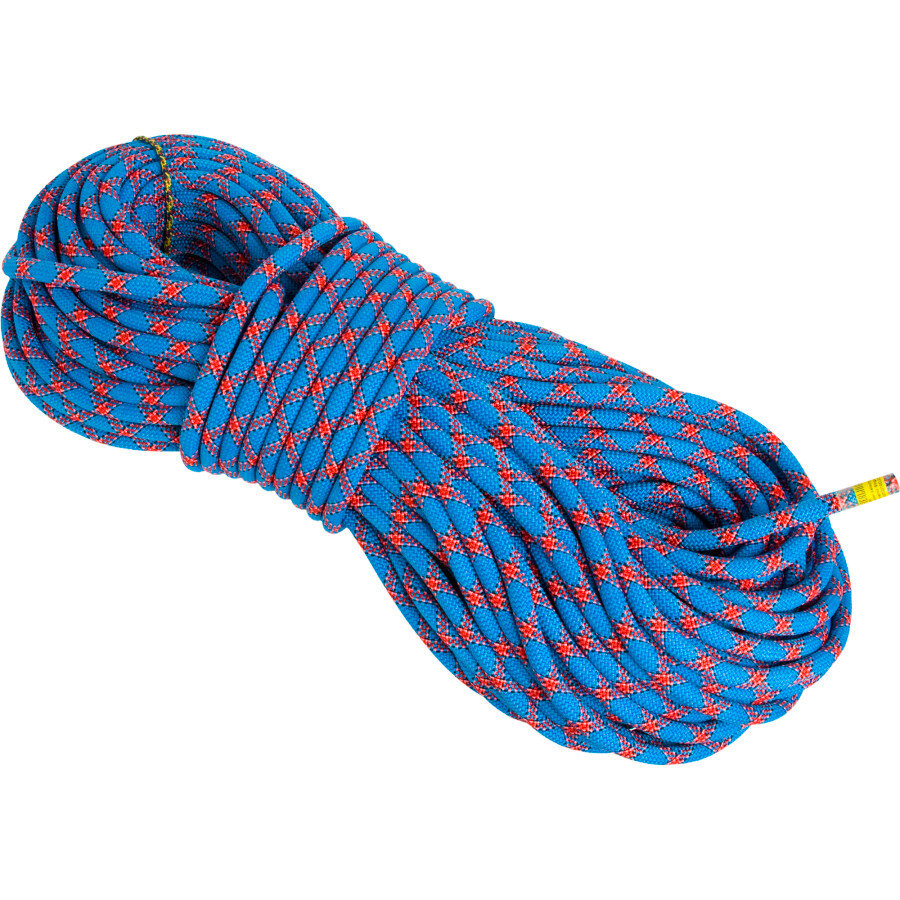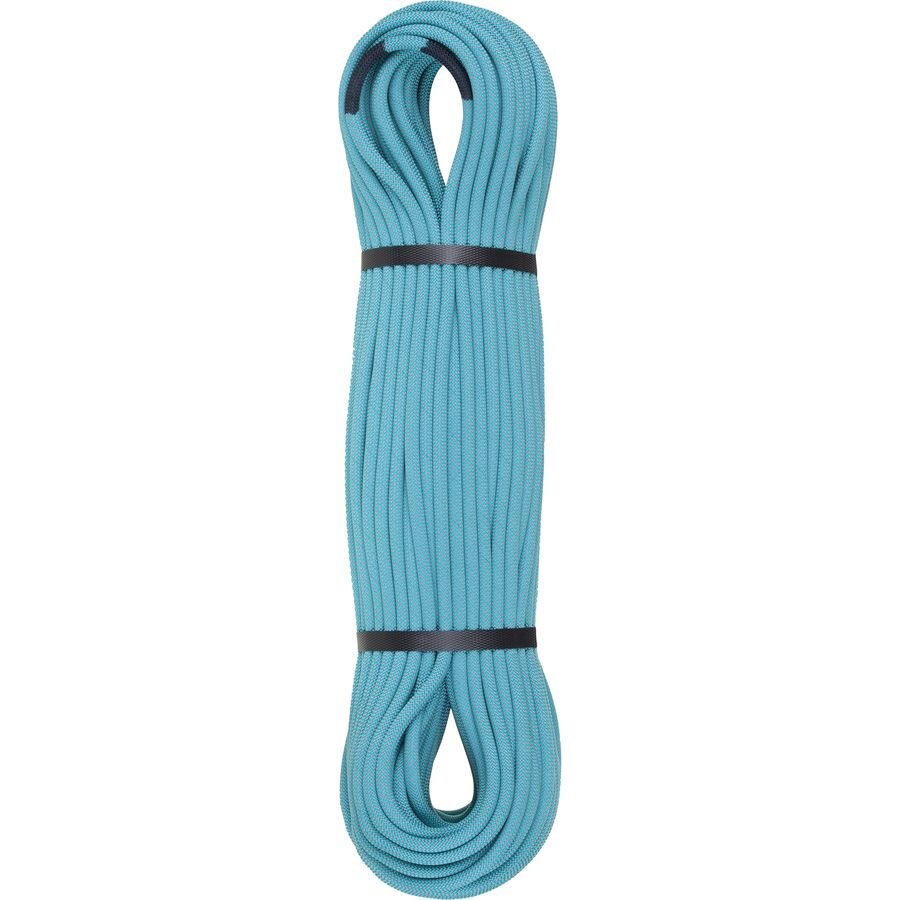Bluesign® = Blue Planet: 16 Eco Rock Climbing Ropes
Ever wondered how your climbing rope was made? What about the impact of the process on the planet?
Most of us have had these thoughts only fleetingly, if at all. For a group that loves and treasures the integrity of the wild so much, we turn a convenient blind eye to the impact our gear makes.
As climbers, it’s time we take start taking ethical and environmental responsibility for our climbing beyond our behavior at the crag itself. Climbing stewardship is more than just choosing to not litter or partake in practices that might damage the rock. It means choosing eco friendly climbing gear from ethical outdoor gear brands long before we even get out to crag.
We can do things like choose to buy used gear over new gear (though please don’t buy used climbing ropes, folks) and vegan rock climbing shoes rather than leather ones (of which the tanning process is horrible for the environment).
We can also make sure our figure eights are environmentally friendly with sustainable and eco rock climbing ropes.
*This post contains affiliate links.
What does it mean to be a sustainable climbing rope?
Buying ropes can be enough of a headache: rope types, fall ratings, diameters, static elongation, thick or thin rope? So many things to consider! And that’s not even to mention the tough choice between that beautiful blue bicolor and vibrant purple rope. But above all that, the best climbing ropes are those that not only keep you safe, but the planet as well.
The biggest criteria we currently have for judging the impact of a climbing rope is knowledge of the chemicals used to make it. There’s no getting around the fact that ropes are made of synthetic (i.e. petroleum-based) fibers which are inherently unsustainable. But we can at least make sure they aren’t soaked in dangerous chemicals that will find their way back into the environment.
That’s where the hat it’s been bluesign® certification comes into play.
The bluesign® system is aimed at creating a more eco friendly textile production criteria. It’s an “input-stream management” assessment that takes into account a material’s production impact on five major environmental areas: resource productivity, consumer safety, water emissions, air emissions, and occupational health and safety. It’s determined by a third-party on-site factory audit meaning there’s no chance a company can greenwash their processes.
The overall production impact assesses any chemicals used in fabric processing and divides them into color categories: blue (safe), gray (special handling required), and black (no no). To achieve the bluesign® seal of approval, all chemicals must fall into the blue category.
Why is this important? Because safe chemical usage is first and foremost better for the environment at the manufacturing stage. It means that factory run-off and air emissions aren’t so damaging. If you’re a numbers person, bluesign® manufacturing equals:
62% CO reduction
89% decrease in water consumption
63% decrease in energy usage
63% reduction in chemical usage
It also means that when the textile reached the end of its life, it’ll leach less toxic elements back into the earth as it degrades. On the ethical front, factory workers and consumers will be exposed to far less dangerous chemicals.
The result is a far more environmentally sustainable climbing rope.
Bluesign® Certified Climbing Ropes
Ethical outdoor gear brand Edelrid was the first climbing company (unless you count Patagonia as a climbing company) to become bluesign® certified in 2009. Mammut also now makes fully bluesign® certified eco friendly climbing ropes, and Sterling is undergoing the process of switching to fully bluesign® certified fibers.
Other companies make bluesign® sustainable climbing ropes, but not across the board as Edelrid and Mammut. Always do your research (or use this list, as we’ve done it for you!).
Edelrid is one of the leading sustainable and eco friendly climbing gear companies (hence their slogan #ClimbGreen) because they also use a PFC-Free Waterproof Treatment for all dry ropes. PFC (short for perfluorocarbons) are present in all kinds of waterproof outdoor gear (from jacket to non-stick pans) despite the fact that they are toxic and persist in the environment and human body for a long period of time. Edelrid explains the pros/cons to PFC in this video. Note that Ocun ropes are also PFC-free (though they don’t yet have a bluesign® approval).
Sterling Ropes is another eco climbing rope brand. While only a few of their 2020 ropes have started being made with bluesign® approved fibers, Sterling has long been minimizing their impact in other ways. Of all Sterling materials purchased, they use 95% of them in making ropes, leaving very little production waste. The remaining 5% is donated to fabric recycling plants. Any rope end offcuts (aka “prime shorts”) and damaged ropes are also sold or donated to other companies who make use of them.
Also be sure to check out the Sterling Recycling Program. They’ll take back ANY dynamic rope (not just theirs) and recycle it for you.
Safety Note on Static Vs. Dynamic Rope: All of the sustainable climbing ropes listed here are dynamic ropes (which if you’re a climber, hopefully you know what that means). For those who are just getting into the sport, this means the rope has a degree “static elongation”, which is the percentage by which is stretches when bearing a load. It’s imperative to rock climb on a dynamic rope as opposed to a static rope because it better disperses the force of a fall (making it more gentle on the falling climber and the protection). A big enough fall on a static rope could break your back.
Navigation for Sustainable Climbing Ropes
Single Ropes
Single / Half / Twin Ropes
Half / Twin Topes
Climbing Rope Recycling
TOP PICKS FOR ECO FRIENDLY CLIMBING ROPES:
The best eco friendly rock climbing rope on this list is the brand new Edelrid Tommy Caldwell Pro DuoTec 9.6mm rope. They had us at Tommy Caldwell, frankly. Other than the fact that this is a collab between one of the most outspoken climbers for conservation and the most sustainable climbing brands, but it has a burly UIAA 9-fall rating for its lightweight and slim design. It also features a Thermo Shield treatment and 3D lap-coiled design making it durable, supple to handle, and coil-resistant.
The Edelrid Swift Eco Dry and Edelrid Boa Eco recycled fiber climbing ropes are a close second. Essentially, Edelrid collects all scrap yarn from other rope production and spins them into these funky, multi-colored ropes. They’re just as safe as normal ropes, but the process to make rope out of shorter fibers requires is more labor-intensive (which is why it’s not yet widely done). At 9.8mm and available in a variety of lengths, it’s perfectly versatile for just about any sport and trad climbing, though it is not dry treated for ice or alpine use.
Now… where to buy climbing rope that’s eco friendly?
ECO ROCK CLIMBING ROPES: SINGLE ROPES
Edelrid Tommy Caldwell Pro DuoTec
Type: single
Diameter: 9.6mm
Lengths: 70m
Dry Treatment?: Yes
UIAA Fall Rating: 9
Find it here: Backcountry / REI / Amazon / Moosejaw
Edelrid Boa Eco
*Made from yarns leftover from other rope production*
Type: single
Diameter: 9.8mm
Lengths: 40m, 60m, 70m
Dry Treatment?: No
UIAA Fall Rating: 7
Find it here: Backcountry / REI / Amazon
Sterling Evolution Velocity
NOTE: All new 2020 Sterling ropes will use bluesign® approved fibers.
Type: single
Diameter: 9.8mm
Lengths: 35m, 40m, 60m, 70m
Dry Treatment?: Optional
UIAA Fall Rating: 6
Find it here: Backcountry / REI / Amazon / Outland USA / Moosejaw
Beal Booster
Type: single
Diameter: 9.7mm
Lengths: 60m, 70m
Dry Treatment?: Yes
UIAA Fall Rating: 8
Find it here: REI / Amazon / Outland USA / Moosejaw
Image credit Mammut
Mammut Infinity Classic
Type: single
Diameter: 9.5mm
Lengths: 60m, 70m
Dry Treatment?: No
UIAA Fall Rating: 7-8
Find it here: Backcountry / Amazon
Mammut Infinity Protect
Type: single
Diameter: 9.5mm
Lengths: 80m
Dry Treatment?: No
UIAA Fall Rating: 8-9
Image credit Mammut
Mammut Eternity Protect
Type: single
Diameter: 9.8mm
Lengths: 60m, 80m
Dry Treatment?: Yes
UIAA Fall Rating: 9-10
Find it here: Amazon
Mammut Gym Classic / Gym Workhorse
Type: single (best as gym climbing rope)
Diameter: 9.5mm, 9.9mm
Lengths: 40m
Dry Treatment?: No
UIAA Fall Rating: 6-9
Find it here: Backcountry / REI / Amazon / Moosejaw
ECO ROCK CLIMBING ROPES: SINGLE / TWIN / HALF ROPES
Edelrid Swift Eco Dry
Type: single, twin/half
Diameter: 8.9mm
Lengths: 60m, 70m, 80m
Dry Treatment?: Yes
UIAA Fall Rating: 5 (single), 22 (half), 22 (twin)
Find it here: Backcountry / REI / Amazon / Moosejaw
Edelrid Canary Pro
Type: single, half/twin
Diameter: 8.6mm
Lengths: 70m
Dry Treatment?: Yes
UIAA Fall Rating: 5 (single), 24 (half), 30 (twin)
Find it here: Backcountry / Amazon / Moosejaw
Beal Joker Unicore / Unicore Golden / Unicore Dry Cover
Type: single, half/twin
Diameter: 9.1mm
Lengths: 60m, 70m
Dry Treatment?: Yes
UIAA Fall Rating: 5 (single), 20 (half), 25 (twin)
Find it here: Backcountry / REI / Amazon / Outland USA / Moosejaw
ECO ROCK CLIMBING ROPES: HALF / TWIN ROPES
Edelrid Skimmer Pro
Type: half/twin
Diameter: 7.1mm
Lengths: 60m, 70m
Dry Treatment?: Yes
UIAA Fall Rating: 5 (half), 10 (twin)
Find it here: Backcountry / Amazon
Mammut Phoenix
Type: half/twin
Diameter: 8mm
Lengths: 30m
Dry Treatment?: Yes
UIAA Fall Rating: 9-10 (half), 20+ (twin)
Mammut Genesis
Type: half/twin
Diameter: 8.5mm
Lengths: 60m
Dry Treatment?: Yes
UIAA Fall Rating: 12-13 (half), 20+ (twin)
RECYCLING OLD CLIMBING ROPES
As climbers, we have to retire out ropes (more frequently than any of us would like), but that doesn’t mean it has to be totally wasteful. There are so many crafty rope projects out there! Consider recycling your climbing rope in one of the following ways:
Weave a recycled climbing rope rug for your van or house: A great way to both upcycle and add some dirtbag decor to your pad. I’ve made several climbing rope rugs over time using this template. It’s pretty straightforward once your understand it but is a pretty tedious undertaking. Climbing rope crafts make for awesome gifts for rock climbers!
Donate for dogs by letting someone turn it into a climbing rope leash Companies like Wilder Dog, Mountain Dog, and Ropes for Rescue, gladly accept retired climbing ropes and turn them into leashes that they either sell or donate to animal shelters in needs. Or if you have a dog yourself who likes to chew through leashes, a 60m climbing rope can give you a healthy backstock of climbing rope leashes.
Upcycle it into a climbing rope yoga sling: Turn it into a minimalist way to tote your yoga mat around.
Donate it to Newseed: If you live in Europe (or find yourself there on a climbing trip), Newseed takes in old climbing ropes and remakes them into fun climbing products like chalk bags.
Send it to Sterling Recycling Program: Again, any dynamic rope, no matter the brand, and they’ll recycle it for you.
**This post contains affiliate links to support the continued creation of these van life guides. This just means that if you purchase one of these eco rock climbing ropes from one of the links above, I get a small commission from the sale at no cost to you. Read more here or reach out with more questions.
















